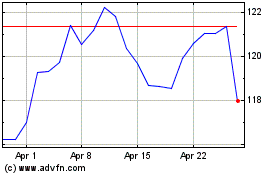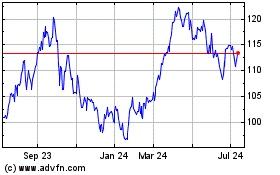Exxon, Chevron Fall Short Despite Rising Prices -- 2nd Update
February 02 2018 - 2:57PM
Dow Jones News
By Bradley Olson
America's biggest oil companies surprised investors with
quarterly profits that missed expectations stoked by rising crude
prices.
Exxon Mobil Corp. and Chevron Corp. on Friday reported quarterly
net income of $8.4 billion and $3.1 billion, respectively. But most
of the gains stemmed from one-time benefits related to the tax
changes approved by Congress and signed into law by President
Donald Trump late last year.
Exxon said its production fell by about 130,000 barrels a day
and its U.S. drilling business lost money for the 12th consecutive
quarter, showing continued struggles in an area where the company
is making a vast expansion. Exxon also reported a $1.3 billion
write-down on its natural gas properties, the second year in a row
it has had to recognize the declining value of certain prospects,
something it rarely did before oil prices crashed in 2014.
Chevron was hit by falling profits in its California refining
business, as well as charges related to hurricanes Harvey and Nate.
Chief Executive Michael Wirth, who took over this month for
predecessor John Watson, said reducing costs and focusing on
returns will be his priority.
"We are a cyclical commodity business," he said in a call with
analysts. "Capital discipline always matters. Costs always
matter."
Exxon shares fell more than 5%, their stock's biggest one-day
percentage drop in five years.
"The U.S. results were disappointing," said Brian Youngberg, an
analyst with Edward Jones in St. Louis. "Production declines are a
continuing challenge for this company. They need to jump-start the
growth for investors to get excited again."
Chevron shares declined 3.4%.
The Exxon and Chevron results were in contrast to the companies'
big oil counterparts, whose executives have said that rising prices
for oil, currently around $65 a barrel, have led them to expect
2018 to be the best year since crude sold for more than $100 a
barrel.
Royal Dutch Shell PLC saw profits triple, nearing levels last
seen before oil prices crashed in 2014. ConocoPhillips said net
income was $1.6 billion, the highest quarterly profit in three
years.
Oil and gas investors in the last year have begun to revolt
against companies that have failed to perform for shareholders. Oil
prices have surged by about 35% in the last six months. Exxon's
shares have risen just 5%, and Chevron's 9%.
U.S. production in November came close to surpassing an all-time
monthly record set in 1970 of more than 10 million barrels a day.
The U.S. may soon surpass Saudi Arabia and Russia, according to the
International Energy Agency.
Even as the biggest U.S. companies fell short of expectations,
the sector is likely to generate more cash in 2018 than it did
during some period of the boom era when oil sold for more than $100
a barrel, according to Simmons & Co. The amount of cash in
excess of new spending and dividends could approach $40 billion in
2018, the most in more than a decade, according to the
analysis.
Healthy global economic growth has created solid demand for oil,
pushing up profits all over the world for refining oil into
gasoline and other products. In some areas, those margins are set
to surge by as much as 15% in 2018, according to Evercore ISI,
above levels that were already near records.
Exxon reported a more than $8 billion profit in the last three
months of 2017 as it recorded a $5.94 billion benefit from the new
tax law. That was up from earnings for the same quarter a year
before of $1.68 billion, or 41 cents a share.
On an adjusted basis, which omits the bump from the new tax law
and impairments, earnings fell 2.2% to $3.73 billion, or 88 cents a
share. Analysts polled by Thomson Reuters were expecting adjusted
earnings of $1.04 a share.
Exxon Chief Executive Darren Woods plans to triple production in
the red-hot Permian basin of West Texas and New Mexico and spend
$50 billion in the U.S. over the next five years, a strategy that
was touted by Mr. Trump in his state of the union speech.
Chevron earnings rose more than sevenfold from a year ago, but
primarily because of the tax benefit. Net income rose to $3.11
billion, including a $2.02 billion benefit related to tax
legislation.
In contrast to Exxon, Chevron's oil and gas production rose by
almost 3% to 2.7 million barrels a day as new projects in Australia
increased output and the company ramped up in west Texas. Chevron
also boosted its quarterly dividend by 4% and signaled that more
cash returns to shareholders could be on the way if oil prices
remain near current levels.
--Allison Prang and Sarah Kent contributed to this article.
Write to Bradley Olson at Bradley.Olson@wsj.com
(END) Dow Jones Newswires
February 02, 2018 14:42 ET (19:42 GMT)
Copyright (c) 2018 Dow Jones & Company, Inc.
Exxon Mobil (NYSE:XOM)
Historical Stock Chart
From Mar 2024 to Apr 2024

Exxon Mobil (NYSE:XOM)
Historical Stock Chart
From Apr 2023 to Apr 2024
